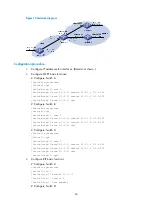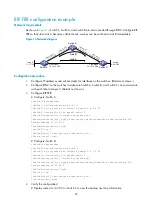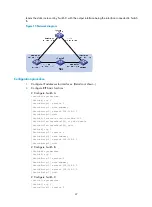
32
Step Command
Remarks
3.
Enable split horizon.
rip split-horizon
Optional.
Enabled by default.
Enabling poison reverse
The poison reverse function allows an interface to advertise the routes received from it, but the metric of
these routes is set to 16, making them unreachable. This can avoid routing loops between neighbors.
To enable poison reverse:
Step Command
Remarks
1.
Enter system view.
system-view
N/A
2.
Enter interface view.
interface
interface-type
interface-number
N/A
3.
Enable poison reverse.
rip poison-reverse
Disabled by default.
Configuring the maximum number of ECMP routes
Perform this task to implement load sharing over ECMP routes.
To configure the maximum number of ECMP routes:
Step Command
Remarks
1.
Enter system view.
system-view
N/A
2.
Enter RIP view.
rip
[
process-id
] [
vpn-instance
vpn-instance-name
]
N/A
3.
Configure the maximum
number of ECMP routes.
maximum load-balancing
number
Optional.
8 by default.
Enabling zero field check on incoming RIPv1 messages
Some fields in the RIPv1 message must be zero. These fields are called "zero fields." You can enable zero
field check on received RIPv1 messages. If such a field contains a non-zero value, the RIPv1 message will
not be processed. If you are certain that all messages are trustworthy, then disable zero field check to
save CPU resources.
This feature does not apply to RIPv2 packets, because they have no zero fields.
To enable zero field check on incoming RIPv1 messages:
Step Command
Remarks
1.
Enter system view.
system-view
N/A
2.
Enter RIP view.
rip
[
process-id
] [
vpn-instance
vpn-instance-name
]
N/A
3.
Enable zero field check on
received RIPv1 messages.
checkzero
Optional.
Enabled by default.
















































